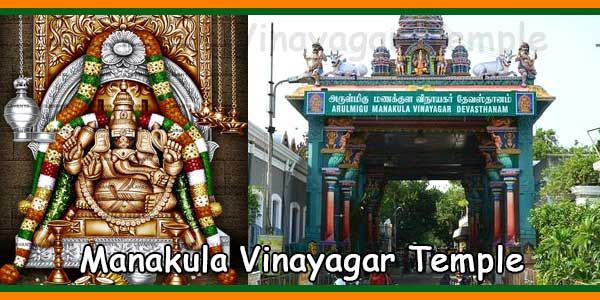Article by P.Raja, posted in Sapthagiri Magazine
Arulmigu Manakula Vinayagar Temple, Pondicherry
Every temple is a place of great importance and it forms the very crux of almost every pious Hindu’s existence. As everything is done with the blessings of the Lord, the Hindus invariably go to temples to offer their prayers.
There was a time when temples played multipurpose roles in the life of the people. Apart from a place of worship, a temple was also a court of law, a center for distributing medicine, a school where education was given free of cost to the privileged few, and a yoga-practicing hall.
A consolation center for bereaved souls and a savior of folk arts, the temple also played the role of a provision hub during times of famine. It was also a museum of architecture and paintings.
Seeking the blessing of the Lord in a temple is a custom in our land. The Lord’s blessing can be sought only through prayer. Knock and it shall open. Ask and it will be given. The blessing people receive from the Lord is not only meant for that day but all the days to come.
People pray to God saluting Him all the time with their palms joined together. It symbolically means that they are together; they think alike; and their vibrations are in harmony with each other. The action denotes the recognition of soul and soul force.
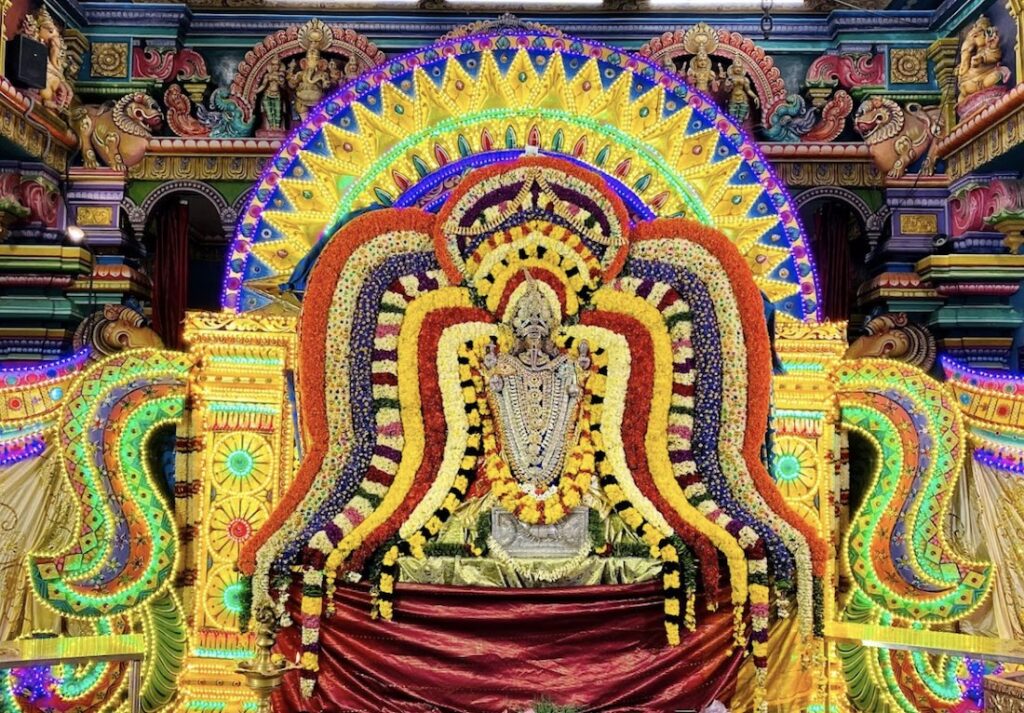
Saluting as per Dharma Shastras
Dharma Shastras have devised certain codes of conduct in saluting others.
- The guru or the teacher should be saluted by placing the joined palms against our forehead.
- The father, responsible for our sojourn on planet Earth, and the king who cares for our safety deserve to be saluted by placing the joined palms close to our mouths and noses.
- Wise men, sages, and elders should be saluted with both palms joined together in front of our chest.
- The mother takes the best of places in the human body. She should be saluted with both hands joined together in front of our navel.
Inside the temples, the deities should be saluted with the palms joined together and raised above our heads.

All these parts of our body play significant roles. The belly, the heart, the nose, the mouth, the head, and the overhead are symbols of a healthy body, happiness, long life, knowledge and prosperity, and enlightenment respectively.
Spiritual science also explains that the force generated by the soul in its field of electricity and magnetism is stored in three important centers of the body and made to radiate from here to different parts. To raise our palms together above our heads is to say that the lord is above everything else.
It is good to meet the Lord quite often to receive His blessings. We get the satisfaction of being blessed by the Lord Himself and the blessed being can be sure of the fruits thereof.
The Glorious Manakula vinayagar Temple
Folklore and History vie with each other to say a lot about a temple for the pot-bellied and elephant-headed God, Lord Ganesh, in Pondicherry. A favorite among locals and tourists alike, He is also a much sought-after God.
Word – Manakula
Regarding the name ‘Manakula’, two different interpretations exist.
- The word ‘Manakula’ is a combination of two Tamil words – Manam (Mind) + Kulam (Pond). In a pond like a mind, a fallen dead leaf too can create a ripple. Vinayagar’s blessings, it is believed, will make the mind unperturbed and calm. That may be a symbolic interpretation.
- The following down-to-earth interpretation is more appropriate: Manal (Sand) + Kulam (Pond).
Old Pondicherry was punctuated with a lot of ponds surrounded by dunes. A deity, mostly Vinayagar, was installed on the bank of the pond. That made it conducive for the local people to worship the deity immediately after their bath in the pond. Hence the name Manakula Vinayagar.
Manakula Vinayagar temple is the only Hindu temple in the French Quarters of Pondicherry, while the Tamil quarters house several temples on every street. To our doubt ‘why?’ the following folktale typical of Pondicherry clarifies it thus: Long ago when Europeans ruled Pondicherry there lived an atheist who was a bosom friend of the governor of the colonized territory. No one knows for certain whether the governor and his friend were Dutch, Portuguese, English, or French, for these were the four who ruled this historically renowned place at different times.
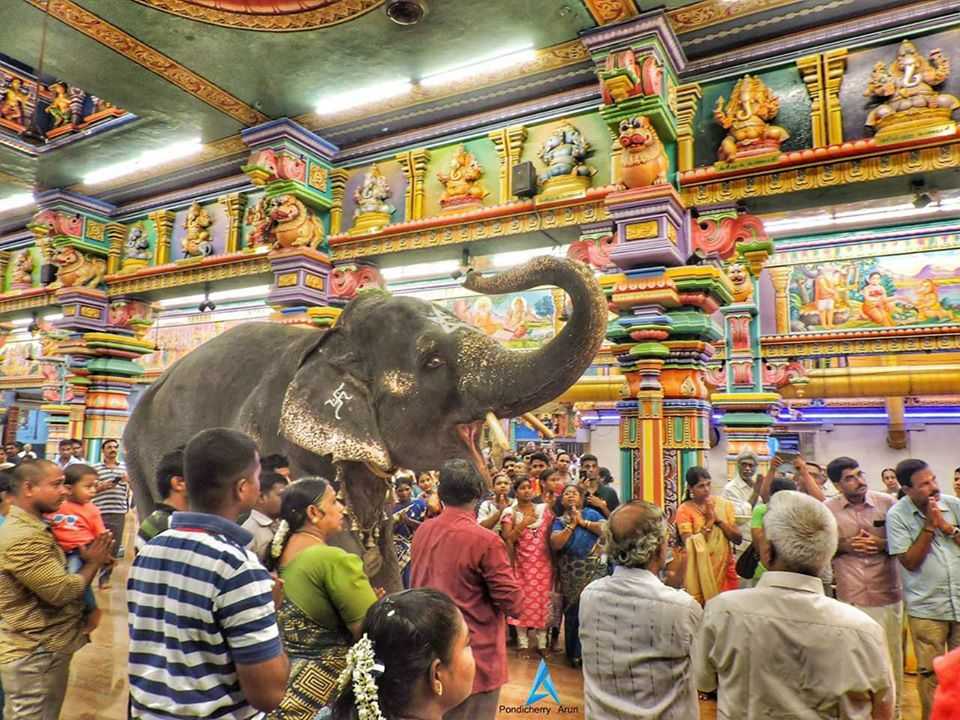
Story of Manakula Vinayagar Temple
To come to the story, the atheist behaved like a despot and quite often ill-treated the natives. The governor neither questioned his attitude nor lent his ear to the grievances of the natives. Since none dared to question him, the atheist poked his nose into the worship of Hindu idols. He had often seen the natives going to a temple, very near to the sea. He had nurtured a strong desire to throw away the idol of the temple into the sea and demolish the temple.
One day the atheist went with his henchmen to see what the natives did in the temple. He was taken by surprise when he entered the temple. Some people prostrated themselves before the image; some lit camphor and broke coconuts against the stone slabs; some closed their eyes and recited mantras while some stood silently praying to the Lord. What was more surprising to the atheist was the curiously shaped image that the natives called God.
The image had a big and oval face with a long trunk for a nose. It had a pot-like belly and its colour was pitch black. “What the hell is the name given to the half elephant and half glutton?” the atheist enquired of his men. “They call it Pillaiyar,” replied someone in his gang. The atheist laughed and his villainous laughter brought utter silence in the temple.
Atheist – Tried to throw stone image into the sea
Everyone shivered. “Go and lift that stone which they call God and throw it into the sea,” he commanded his henchmen. The unruly gang immediately jumped into action. Helpless, the natives stood watching the evil action of the vandals. With great difficulty, they lifted the image and carried it to the seashore.
They boarded a catamaran with the image, while the atheist stood on the shore happily watching their movements. Soon his men returned to tell him that the stone image had been thrown into the deep sea. Happy at heart, the atheist with his followers marched towards the temple to bully and insult the natives. But he was taken aback to see the image of Pillaiyar seated in the very same place in the temple.
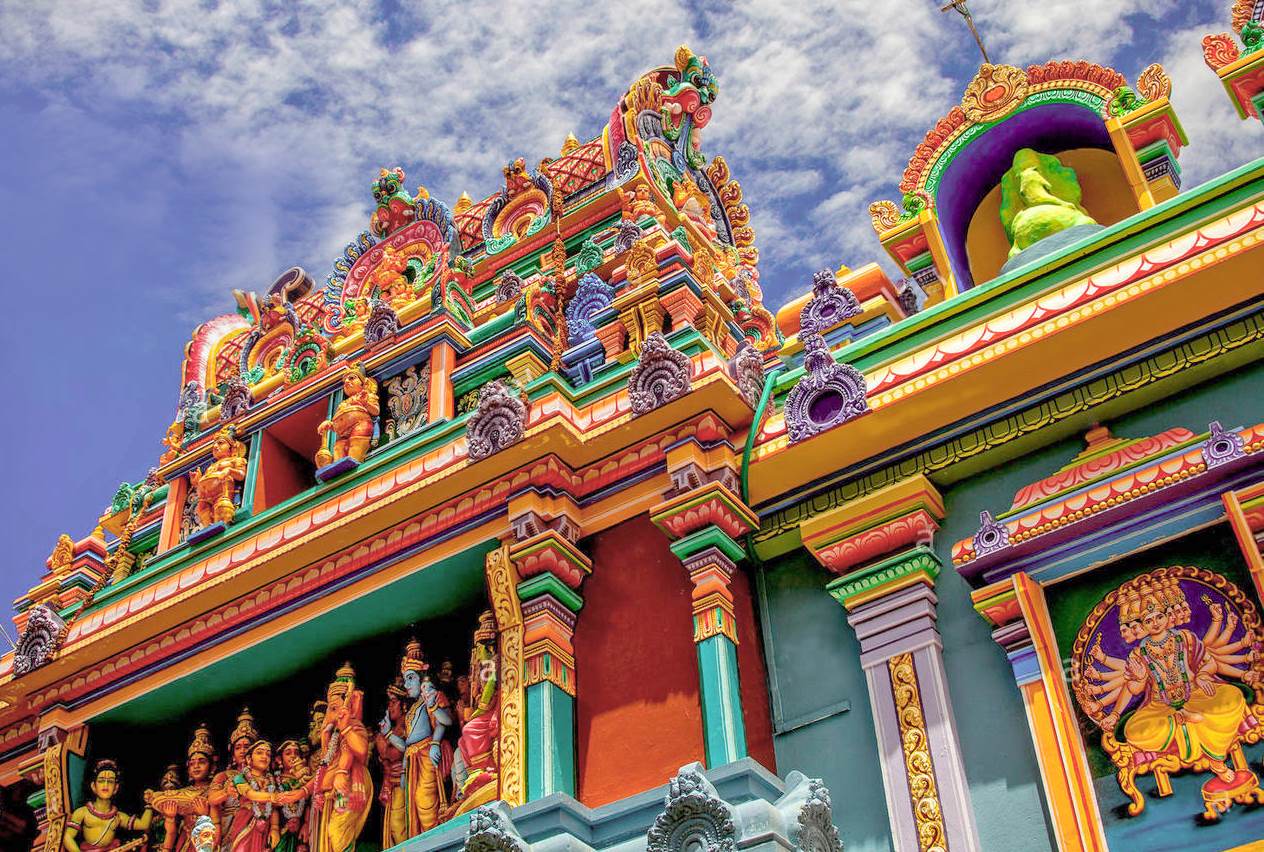
The reappearance of Stone Image (God)
He saw the natives praying in silence. He knew well that the natives could not have brought in another image within that short time. But at the same time, he wondered at the sudden reappearance of the image. “How did that stone come back?” he shouted at the natives in the temple. “We do not know. When you left this temple we prayed with our eyes closed. And when we opened our eyes we saw Him seated in the vacant place,” said a native. “Is that so? Does that stone presume to set its wits at me?” the atheist roared.
He then commanded, “Carry the statue. Tie it to a bigger stone. Go a long distance into the sea and roll the stones together into the depth of the sea”. His order was obeyed. But when they came back to the temple they were shocked to see the Pillaiyar again. Suspecting some foul play, the atheist stared at the smiling faces of the natives. One mustered courage and said, “This Pillaiyar is a very powerful deity. No force on earth can destroy Him”.
Final Attempt
The atheist wanted to make a final attempt. He told his men to lift the image and take it to the seashore. When it was done he asked all the natives who had gathered in the temple to quit the place. He then closed the doors of the temple and locked it.
Carrying the key with him, he went to the seashore and boarded a boat with his companions and the image. Under his supervision, the image was thrown into the deep sea. With great satisfaction, they returned to the temple. When the atheist unlocked the doors of the temple, he was horrified to note the reappearance of the Pillaiyar.
A large crowd had already gathered there. Many laughed at the foolish action of the atheist. Sneering at the crowd, the atheist ordered his men to fetch crowbars.
Gangsters trying to break
When the weapons reached the place, he commanded, to the sorrow of the natives, “Use these crowbars against their Pillaiyar and break the idol into pieces. Let the powerful deity save himself”. The gangsters began to smash the sharp edges of their crowbars against the image. But they could not make even a dent in it. They repeated their action but to their great disappointment, the crowbars broke up into tiny pieces and fell. A splinter from a broken crowbar flew whizzing toward the atheist and hit his right kneecap. Crying in pain he fell before the image.
Later it was reported to the governor that the atheist went to the temple every morning and evening without fail to worship Pillaiyar, the powerful deity. No wonder that the governor realizing the unquestionable powers of the Lord, arranged for a decent construction to house Lord Vinayagar. Hence the name ‘Vellakaran Pillayar’ (Whiteman’s Vinayaga).
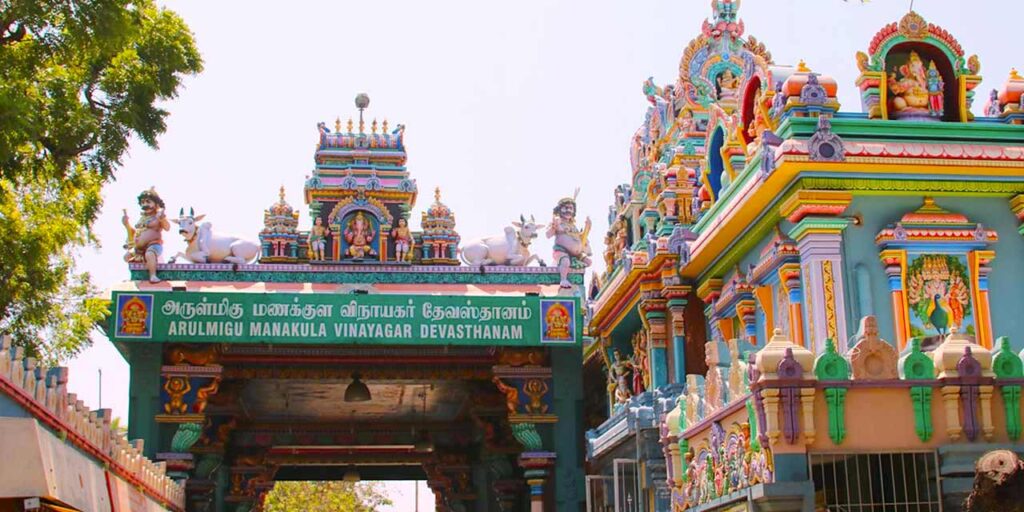
Stopping Natives from worshipping
The fact that Francois Martin, the Founder of Pondicherry, tried to stop the natives from worshipping the Lord or performing any form of Pooja in 1674 proves without an iota of doubt that the temple is nearly five centuries old.
As the story goes, the weavers and others who lived in that area planned an exodus for they believed that it was foolish to live in a place where worship of the deity was banned. And Martin has no other go but to lift his ban for without those weavers his company would have undergone a heavy loss. It must be mentioned in passing that during the reign of Dupleix, Manakula Vinayagar, and His abode remained undisturbed although Madame Dupleix was bent on transforming the places of Hindu worship into churches.
Diary of Ananda Ranga Pillai
An uxorious Dupleix had no way but to lend deaf ears to the complaints and grumbling of the locals. Another proof of its existence and survival can be seen through the famous Diary of Ananda Ranga Pillai (1709-1761). The most famous Tamil diarist to date, Pillai was Dubash to Monsieur Dupleix, the French Governor-General of French India. The Diary he maintained from 1736 till his death immortalized him as it was a record of matters political, social, and personal. Being an eyewitness report of the manners of the court and society, it is an invaluable treasure.
Ranga Pillai’s keen observation, fostered by his status in society, made his Diary a sourcebook of history. Very interested in contemporary events, he records in it “the valuable account of things historical, political and social appertaining to the period embracing the rise, the Zenith and the decline of French power in India.” The Diary opens to us vistas of bygone times. We are introduced to the customs and manners of the natives in the 18th century. He describes the religious rites and festivals of Hindus and other sects.
Not only do Pongal and Sivarathri other sects find their places in his Diary but also the Fire Festival and the hunting festival. In the entry dated April 7, 1748, Pillai wrote: “…Between half-past eight and nine tonight, Murugu Pillai, the Choultry manager, came to my nut-godown and, standing near the door of the Manakukulam Pillaiyar Temple, called me and asked if I had heard what had been going on in the town for the last two or three days” (Vol.5, p.18).
Another entry dated October 2, 1748
reads: “The shells burst in the air, and twenty or thirty fragments would fly half a mile or a mile. The pieces whistled as they flew, like a kite flying in the air. One shell struck Mir Ghulam Husain’s gate, another struck the Governor’s kitchen house and gardens. Others fell near the tobacco godown and the stable on Vellala Street. Another struck a Topasi woman’s house near the Pillaiyar temple beside the Manakulam tank, and broke her legs…The Europeans, I think, are a hundred times more alarmed than the Tamils. All of them fear the shells. Such is the effect of the shells which the English fire daily.
Many would have been wounded and killed if such had been God’s will; but by His grace, it has been otherwise, and despite all the bombardment, there has been little loss. God’s will is too great for man to comprehend, as all the Shastras say. Is it not true? That was why many of the great and wise renounced worldly pleasures for solitary meditation. All know this…” (Vol.5, P. 381) (The quotes are from H. Dodwell’s English translation of The Private Diary of Ananda Ranga Pillai).
These two entries serve ample testimony to the facts that Ranga Pillai had his tobacco godown quite close to the Pillaiyar temple and his was an unquestionable belief in Pillaiyar’s power.
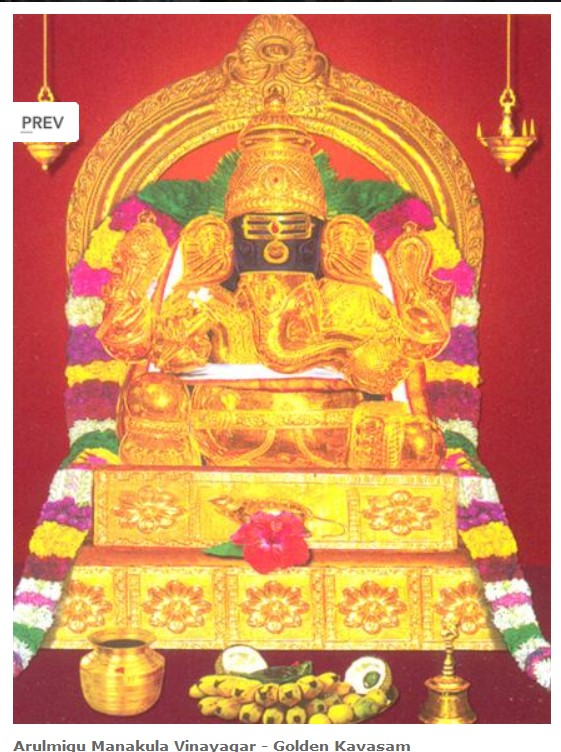
During 17th Century
Perhaps built during the 17th century, it is one of the ancient temples here. Sandwiched between the street that takes us to Sri Aurobindo Ashram and the street to the Governor’s House, this temple facing east is only a stone’s throw from the promenade.
Mahakavi Subramania Bharati and The Mother of Sri Aurobindo Ashram shower their highest honor on this Lord Vinayagar, popularly known among the locals as Manakula Vinayagar.
First, listen to Bharati praying to Pillaiyar during his decade of stay (1908-1918) in Pondicherry:
“…ManakulaVinayagar, Master of the heavenly mystery, Grant to me, I pray, the strength and skill Of self-control. For this gift gained, All other gifts ensure unsought. Grant me firm courage. Then wishing For happiness for all living beings, With the worship of Your Feet my sole vocation, God Ganapati, I shall live in joy.
Sri Aurobindo Ashram
Historians and scholars believe that the Ashram of Sri Aurobindo and the temple are nearer to each other not by accident but on purpose. Lord Vinayaga is chief of all Vedas while Sri Aurobindo is an authority on the Vedas. And both bless all their devotees who come seeking their help. No wonder their abodes are quite close.
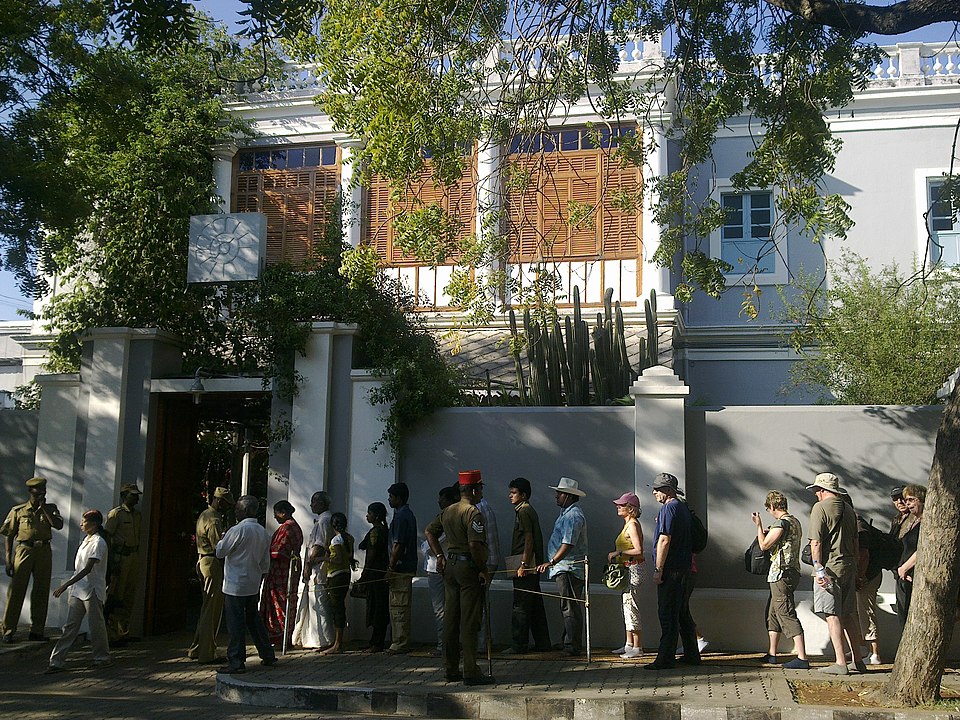
The Mother of Sri Aurobindo Ashram had a special relationship with Pillaiyar. She considered him her friend. On several occasions, she has referred to Ganapathi. The Mother who never recommended idol worship had a statuette of Pillaiyar on her desk. When asked, it is reported that she replied: ‘He is our friend’.
In her letter dated 8th November 1962 (later published in Sri Aurobindo’s Action, March 1980) addressed to her devotee, Mr. Madanlal Himatsingka, she writes: “… each one must invoke Ganesh according to his feeling – the traditional way is not necessarily the best” and continues to narrate her own experience with him, “In 1930 we were having regular meditations in the Prosperity hall, on the significance of flowers.
At one of these meditations, quite unexpectedly, Ganesh appeared suddenly to my inner view. He was of golden light and surrounded by a very luminous golden aura. His form was the usual one as in his images. It was the first time I ever saw him and I expressed some surprise over his sudden appearance. Then he told me, “You see I am a living being quite real and concrete – and to give you a concrete proof of my reality I shall send to you henceforth, all the money you will need. And on this promise, he disappeared. He has kept his promise for years and the money was coming abundantly”.
In the issue dated November 2004 of Sri Aurobindo’s Action, its editor Shri Shyam Sunder writes:
“…In the 1960s when Sri Aurobindo Memorial Fund Society purchased the huge adjacent property bearing premises No. 64, rue d’Orleans (as the present Manakula Vinayagar Koil Street was then known) out of funds provided by Shri Madan Lal Himatsingka, a devotee of the Mother, she arranged the transfer of a small piece of land on the northern side of the property, by way of a gift, to the Ganesa temple to provide the needed suitable space for parikrama inside the temple. As the story goes Ganesa had asked her for it. Ganesa, Mother had told us, had helped her in financing the Ashram” (p.12).
Thus a piece of land measuring roughly 12’x120’ went from Sri Aurobindo Memorial Fund Society to Lord Ganesa and today devotees are happy to go round the deities and do Parikrama. What a wonderful gift of the Mother of Sri Aurobindo Ashram to Lord Ganesa who kept his word!
No wonder that visitors to the Ashram from different corners of the globe rush to have His blessings as well.
Thousands of Pillaiyar devotees throng His abode every day and on Fridays, not to speak of Vinayaga Chaturti festival, it is always a milling crowd. Twowheelers, four-wheelers, and heavy vehicles pay their homage to the Lord before they start serving their new masters. Visitors to the Ashram from different corners of the globe rush to have His blessings as well.
A ten-day festival in Manakula Vinayagar Temple is celebrated every year since 1957 and each day’s expenditure is met by a particular community in the town.
Kindly visit our BLOG page for POPULAR ARTICLES
